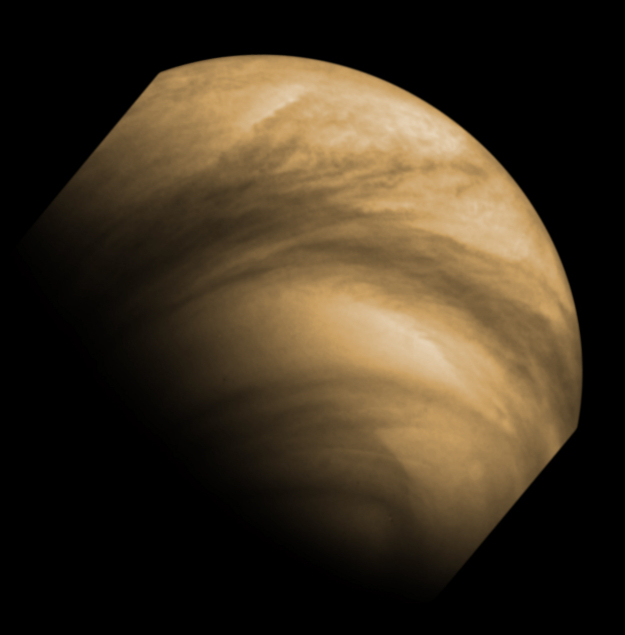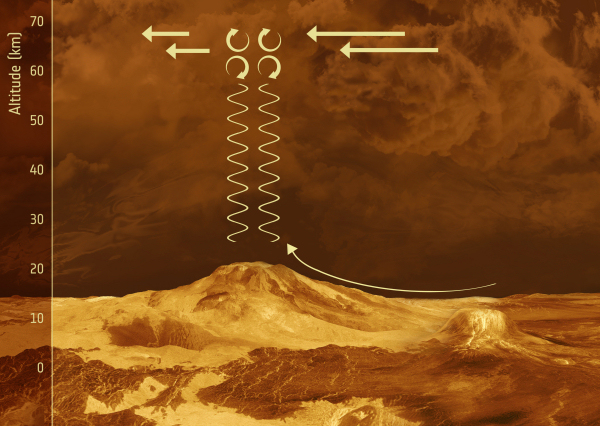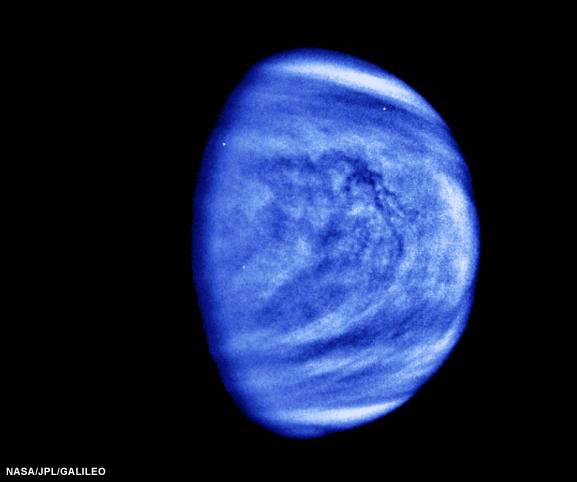Giant Mountains On Venus May Cause Its Weird Weather Patterns

The mountains in Venus' Aphrodite Terra region may prompt the strange weather patterns observed in the thick cloud layer near the top of the planet's insufferable atmosphere, new research shows.
With average surface temperatures of 860 degrees Fahrenheit (460 degrees Celsius), Venus is the hottest planet in the solar system. Venus' atmosphere is made up almost completely of carbon dioxide, creating an extreme version of the greenhouse effect that warms Earth. In addition to trapping heat and blocking light, the thick cloud layer blanketing the planet makes it incredibly difficult for scientists to study its surface.
Using observations from the European Space Agency's (ESA) Venus Express satellite, along with data collected from the SPICAV (Spectroscopy for Investigation of Characteristics of the Atmosphere of Venus) spectrometer, researchers delved into the planet's thick cloud-top layer to get a better idea of the topography that lies beneath. [Photos of Venus, the Mysterious Planet Next Door]
Compared to slow ground-level clouds that coast along the Venusian surface at speeds of about 3 feet per second (1 meter per second), thick clouds seen in the upper part of the planet's atmosphere — between 30 and 45 miles (50 and 70 kilometers) above the surface — experience much more extreme weather, ESA officials wrote in a statement. For example, these cloud tops host drastically colder temperatures of about minus 94 degrees Fahrenheit (minus 70 degrees Celsius) and winds that blow faster than Venus itself rotates — a phenomenon known as super-rotation.
While investigating Venus' strange, cloudy weather, researchers specifically looked at how quickly winds circulate, the brightness of the planet's cloud tops and how much water they store, according to the new study published June 30 in the Journal of Geophysical Research: Planets. The new findings revealed that clouds above Aphrodite Terra — a 15,000-foot-high (4,500 meters) mountain range located near Venus' equator — contain more water vapor than other nearby clouds.
The researchers speculated that this phenomenon — subsequently dubbed the "fountain of Aphrodite" — is the direct result of water-rich air from the lower atmosphere being pushed up over the mountains, creating what are known as gravity waves.
"Despite the [similar] name, these have nothing to do with gravitational waves, which are ripples in space-time," Jean-Loup Bertaux, a researcher from the Laboratoire Atmosphères, Milieux, Observations Spatiales in France and the lead author of the new study, said in the statement. "Instead, gravity waves are an atmospheric phenomenon we often see in mountainous parts of Earth's surface. Crudely speaking, they form when air ripples over bumpy surfaces. The waves then propagate vertically upwards, growing larger and larger in amplitude until they break just below the cloud top, like sea waves on a shoreline."
Get the Space.com Newsletter
Breaking space news, the latest updates on rocket launches, skywatching events and more!
When these gravity waves break above Aphrodite Terra, they slow the otherwise fast-moving, high-altitude winds observed in surrounding areas. Just downstream of Aphrodite Terra, these winds regain speed; this motion "acts as an air pump," according to the statement, and pushes water-rich air to the top of the planet's cloud layer. This creates the observed "fountain" effect above the mountain, according to the new study.

Venus' puzzling atmosphere
Not only is the surface of Venus much hotter than Earth, but the planet's hellish atmosphere is also much drier — even though it contains some water vapor beneath its upper cloud layer.
Previously, researchers found that Venus' upper atmosphere contains mysterious stripes known as ultraviolet absorbers, which soak up blue and ultraviolet wavelengths of light and play a key role in warming the planet.
The new study, however, shows that these unusual atmospheric features form beneath the planet's cloud tops and, in addition to carrying water-rich air, the wind circulation patterns observed near Aphrodite Terra transport that ultraviolet-absorbing material upward through Venus' cloud tops. This suggests that the amount of that material and water found in Venus' cloud tops is "strongly enhanced at particular places around the planet's equator," ESA officials explained in the statement.

"This certainly challenges our current general circulation models," Håkan Svedhem, ESA project scientist for Venus Express, said in the statement. "While our models do acknowledge a connection between topography and climate, they don't usually produce persistent weather patterns connected to topographical surface features. This is the first time that this connection has been shown clearly on Venus — it's a major result."
The Venus Express mission lasted from 2006 to 2014, when the probe ran out of fuel and plummeted into the planet's deadly atmosphere. Observations collected from the satellite during its orbit around Venus allowed researchers to study the planet's long-term weather patterns.
"Crucially, knowing more about Venus' circulation patterns may help us to constrain the identity of the planet's mysterious ultraviolet absorber, so we can understand more about the planet's atmosphere and climate as a whole," Svedhem added.
Follow Samantha Mathewson @Sam_Ashley13. Follow us @Spacedotcom, Facebook and Google+. Original article on Space.com.
Join our Space Forums to keep talking space on the latest missions, night sky and more! And if you have a news tip, correction or comment, let us know at: community@space.com.

Samantha Mathewson joined Space.com as an intern in the summer of 2016. She received a B.A. in Journalism and Environmental Science at the University of New Haven, in Connecticut. Previously, her work has been published in Nature World News. When not writing or reading about science, Samantha enjoys traveling to new places and taking photos! You can follow her on Twitter @Sam_Ashley13.









